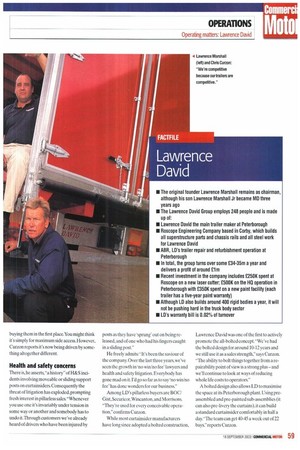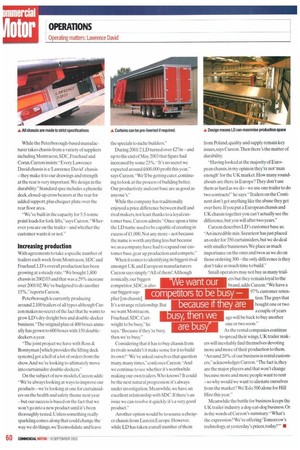TRAILER MADE
Page 58

Page 59

Page 60

If you've noticed an error in this article please click here to report it so we can fix it.
Despite evidence to the contrary, there are differences between the individual makes of
curtainsiders. Brian Weatherley reports.
Acurtainsider is a curtainsider is a curtainsider. Look at any number of them in a trailer park and they all have the same kind of chassis — frequently from the same manufacturer — they all offer easy side and rear-load access, and barring the odd bit of detail here and there, they all look alike. So why should a curtainsider from Lawrence David be any different from the rest?
Sales director Chris Curzon reckons it all boils down to performance.
"I'm biased, but I can look anyone in the eye and say our curtainsider is as strong as, or stronger, than any one of our rivals in the key areas of the chassis at the front and the rear. A Lawrence David curtainsider is built like a brick outhouse!" he adds matter-of-factly.
Load-bearing curtains
While other manufacturers rely on the curtain straps to keep a load inside the body Curzon says: "We've continued to be competitive because of the product. We're the only company to have load-bearing curtains which will support twice the amount of load capacity in the trailer to an angle of 24°," before adding wryly,"and at 20° the trailer would have gone over anyway!"
One element in particular that separates a Lawrence David curtainsider from its rivals is attention to detail."Other manufacturers have carried on with old ideas," insists Curzon. "Their 35mm curtain poles are basically steel bars, We fit hollow poles that are not only lighter but stronger," he says. "We also have easy open/close buckles which are different to our competitors."
Say the word "pillarless" to the average curtainsider buyer and you could quickly be shown the door. Many of the original firstgeneration pillarless designs couldn't stay the course,with the result that operators opted for swing-out or sliding posts. Yet between 80-95% of all Lawrence David curtainsiders are pillarless models how come it succeeded where others failed?
Curzon maintains it's because the original design was right first time. "We're the only company whose curtainsider is 15-years old. We introduced it in the late 80s, and it's still the same design."
It's also a product that can't be easily copied either." Our competitors can't do it the same way as us," reports Curzon,"because ours is covered under licence. So they have to produce something different. All our competitors, including Montracon, Boalloy and Cartwright, they might be alright — but their designs are less then two years old. Ours has 15 years of proven history," Having that track record clearly hasn't hurt. "The biggest problem we've had with selling pillarless has been other people's products," says Curzon. "People who haven't experienced the LD product don't know how successful it is. But those that have, have no problems with it."
So what is the actual difference? Curzon is understandably cagey, but says:"What we've got is effectively a very clever cantilevered bridge design. But the real secret of pillarless is how the front and rear bulkhead is put on the trailer — that's unique to ourselves."
Ironically, what makes LD's pillarless success really significant is why operators are buying them in the first place.You might think it's simply for maximum side access. However, Curzon reports it's now being driven by something altogether different.
Health and safety concerns
There is, he asserts,"a history" of H&S incidents involving moveable or sliding support posts on curtainsiders. Consequently the threat of litigation has exploded, prompting fresh interest in pillarless sales. "Whenever you use one it's invariably under tension in some way or another and somebody has to undo it.Through customers we've already heard of drivers who have been injured by posts as they have 'sprung' out on being released, and of one who had his fingers caught in a sliding post."
He freely admits:"It's been the saviour of the company. Over the last three years,we've seen the growth in no win/no fee' lawyers and health and safety litigation. Everybody has gone mad on it. I'd go so far as to say `no win/no fee' has done wonders for our business."
Among LD's pillarless buyers are BOC/ Gist, Securicor, Wincanton, and Morrisons. "They're used for every conceivable operation." confirms Curzon.
While most curtainsider manufacturers have long since adopted a bolted construction, Lawrence David was one of the first to actively promote the all-bolted concept."We've had the bolted design for around 10-12 years and we still use it as a sales strength," says Curzon. "The ability to bolt things together from a repairability point of view is a strong plus — and we'll continue to look at ways of reducing whole life costs to operators."
A bolted design also allows LD to maximise the space at its Peterborough plant. Using preassembled and pre-painted sub-assemblies (it can also pre-livery the curtains), it can build a standard curtainsider comfortably in half a day. "The team can get 40-45 a week out of 22 bays," reports Curzon. While the Peterborough-based manufacturer takes chassis from a variety of suppliers including Montracon, SDC, Fruehauf and Corus, Curzon insists: "Every Lawrence David chassis is a 'Lawrence David' chassis they make it to our drawings and strength at the rear is very important. We design in the durability." Standard spec includes a phenolic deck, closed-up cross bearers at the rear for added support, plus chequer plate over the rear floor area.
-We've built in the capacity for 5.5-tonne point loads for fork-lifts," says Curzon."Wherever you are on the trailerand whether the customer wants it or not."
Increasing production With agreements to take a specific number of trailers each week from Montracon, SDC and Fruehauf. LD's overall production has been growing at a steady rate. "We bought 1,800 chassis in 2002/03 and that was a 29% increase over 2001/02. We've budgeted to do another 15%," reports Curzon.
Peterborough is currently producing around 2,100 trailers of all types although Curzon makes no secret of the fact that he wants to grow LD's dry-freight box and double-decker business."The original plan of 400 boxes annually has grown to 600 boxes with 150 doubledeckers a year.
"The joint project we have with Ross & Bonnyrnan [which provides the lifting deck systems] got a hell of a lot of orders from the show. And we're looking to ultimately move into curtainsider double-deckers."
On the subject of new models, Curzon adds: "We're always looking at ways to improve our products-we're looking at one for curtainsiders on the health and safety theme next year -but our success is based on the fact that we won't go into a new product until it's been thoroughly tested. Unless something really sparkling comes along that could change the way we do things, we'll consolidate and leave the specials to niche builders."
During 2001/2 LD turned over £27m and up to the end of May 2003 that figure had increased by some 23%. "It's no secret we expected around £600,000 profit this year," says Curzon. "We'll be getting cuter, continuing to look at the process of building better. Our productivity and cost base are as good as anyone's."
While the company has traditionally enjoyed a price difference between itself and rival makers, not least thanks to a loyal customer base, Curzon admits: "Once upon a time the LD name used to be capable of creating in excess off 1,000. Not any more -not because the name is worth anything less but because we as a company have had to expand Our customer base,gear up production and compete."
When it comes to identifying its biggest rival amongst UK and European manufacturers Curzon says simply: "All of them! Although ironically. our biggest competitor. SDC. is also our biggest supplier [on chassis]. It's a strange relationship. But we want Montracon, Fruehauf, SDC, Cartwright to be busy," he says. "Because if they're busy, then we're busy."
Considering that it has to buy chassis from its rivals wouldn't it make sense for it to build its own? "We've asked ourselves that question many,many times," confesses Curzon. "And we continue to see whether it's worthwhile making our own trailers Who knows? It could be the next natural progression:it's always under investigation. Meanwhile,we have an excellent relationship with SDC. If there's an issue we can resolve it quickly; it's a very good product," Another option would be to source a cheaper chassis from Eastern Europe. However, while LD has taken a small number of them from Poland,quality and supply remain key issues, says Curzon.Then there's the matter of durability.
"Having looked at the majority of European chassis, in my opinion they're not 'man enough' for the UK market. How many roundabouts are there in Europe? They don't use them as hard as we dowe use one trailer to do two contracts!" he says. "Trailers on the Continent don't get anything like the abuse they get over here. If you put a European chassis and UK chassis together you can't actually see the difference, but you will after two years."
Curzon describes LD's customer base as: "An incredible mix. Securicor has just placed an order for 350 curtainsiders, but we do deal with smaller businesses.'We place as much importance on the ones and twos as we do on those ordering 300 the only difference is they don't take as much time to build."
Small operators may not buy as many trailers but they remain loyal to the brand, adds Curzon. "We have a 97% customer retention.The guys that bought one or two a couple of years ago will be back to buy another one or two soon."
As the rental companies continue to spread their wings, UK trailer makers will inevitably find themselves devoting more and more of their production to them. "Around 20% of our business is rental customers," acknowledges Curzon. "The fact is, they are the major players and that won't change because more and more people want to rent -so why would we want to alienate ourselves from the market? We'll do 500 alone for Hill Hire this year."
Meanwhile the battle for business keeps the UK trailer industry a dog-eat-dog business. Or in the words of Curzon's summary: "What's the expression? We're offering 'Tomorrow's technology, at yesterday's prices, today!' •




























































































































































































